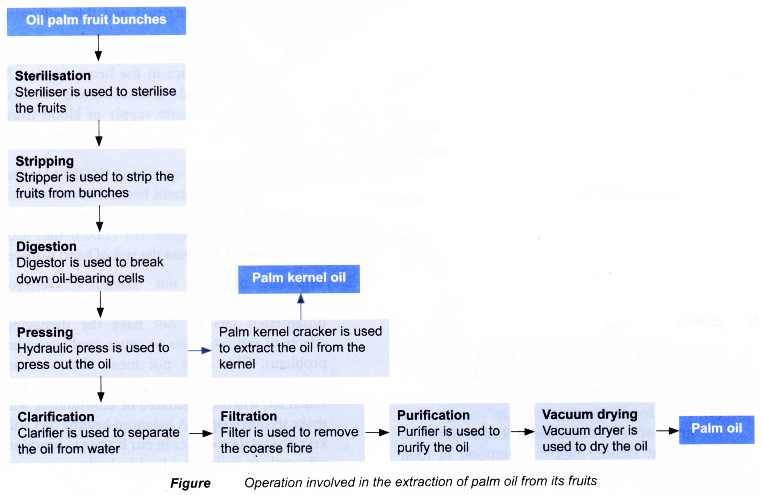How palm oil is extracted?
Malaysia is the world’s second-largest palm oil producer. Palm oil is extracted from fresh oil palm fruits.

The extraction of oil from the fruits has to be carried out within 24 hours from the time the fruits are harvested. This is because the fruits will quickly deteriorate and become spoilt.

What are the health benefits of palm oil?
Advantages of palm oil in food production
- A unique feature of palm oil is that it can be easily processed and refined into various grades of different properties suitable for a variety of food and non-food products. This makes palm oil less expensive than other oils such as groundnut oil, corn oil and sunflower oil.
- Palm oil has numerous health benefits for its users compared to other vegetable oils.
(a) Palm oil contains the highest amounts of natural antioxidants such as vitamin E (tocophenols and tocotrienols) and vitamin A (carotenoids) that help prevent aging, cancer, arteriosclerosis and Alzheimer’s disease.
(b) Palm oil does not contain cholesterol. Instead, vitamin E in palm oil lowers the ‘bad’ cholesterol (LDL) and raise the ‘good’ cholesterol (HDL); helping to reduce the risk of heart attack, to boost the immune system and to fight cancer. - Table shows the composition of palm oil.
Fatty acid Compositon (%) Name Type Palmitic acid Saturated 44 Stearic acid Saturated 5 Oleic acid Monounsaturated 40 Linoleic acid Polyunsaturated 10 Others – 1 - Palm oil contains fats that are beneficial to health. For example, it contains omega-6 fatty acid (linoleic acid) that can reduce cardiovascular risk factors. In fact, the composition of fatty acids in palm oil is very similar to that found in fat tissue in most healthy people.
- Palm oil has a healthy mixture of saturated and unsaturated fats that are easy to digest and absorb. It can supply the energy needed without causing a rise in LDL or insulin levels in the blood.
- Another important property of palm oil is its ability to withstand heat and resist oxidation when cooked at high temperatures. This makes palm oil an ideal ingredient in frying oil blends, In fact, traditional hydrogenated seed oils such as soybean oil and canola oil have been replaced by palm oil in frying products like French fries, doughnuts, noodles and nuts.
- Palm oil is natural because it is not processed with heat or organic solvents. It is also not hydrogenated; palm oil does not contain trans-fatty acids.
(a) Medical studies have shown that trans-fats are responsible for many serious diseases.
(b) Solid fats are needed in the making of certain foods such as biscuits, breads, buns, cakes and pastries. The food industry uses solid fats obtained by hydrogenating vegetable oils. These solid fats contain trans-fatty acids formed during the hydrogenation process.
(c) On the other hand, solid fats made from palm oil do not require hydrogenation, making solid palm fats trans-free.
People also ask
- What are carbon compounds?
- Chemical Properties of Carbon Compounds
- How are alkanes formed?
- What is an alkene in chemistry?
- What is an isomerism?
- What is alcohol and how is it made?
- How are carboxylic acids formed?
- How esters are formed?
- What are fats and oils?
- Order in Homologous Series
- What is the monomer of natural rubber?
- Which acid is used for coagulating rubber from latex?
- Classification of Hydrocarbons
- What is the homologous series of hydrocarbons?
- Properties and Uses of Ethanol
- Properties and Uses of Ethanoic Acid
